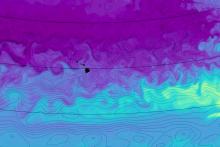Subtropical gyres are enormous rotating ocean currents that generate sustained circulations in the Earth’s subtropical regions just to the north and south of the equator. These gyres are slow-moving whirlpools that circulate within massive basins around the world, gathering up nutrients, organisms, and sometimes trash, as the currents rotate from coast to coast.
For years, oceanographers have puzzled over conflicting observations within subtropical gyres. At the surface, these massive currents appear to host healthy populations of phytoplankton — microbes that feed the rest of the ocean food chain and are responsible for sucking up a significant portion of the atmosphere’s carbon dioxide.
But judging from what scientists know about the dynamics of gyres, they estimated the currents themselves wouldn’t be able to maintain enough nutrients to sustain the phytoplankton they were seeing. How, then, were the microbes able to thrive?
Link to article:



